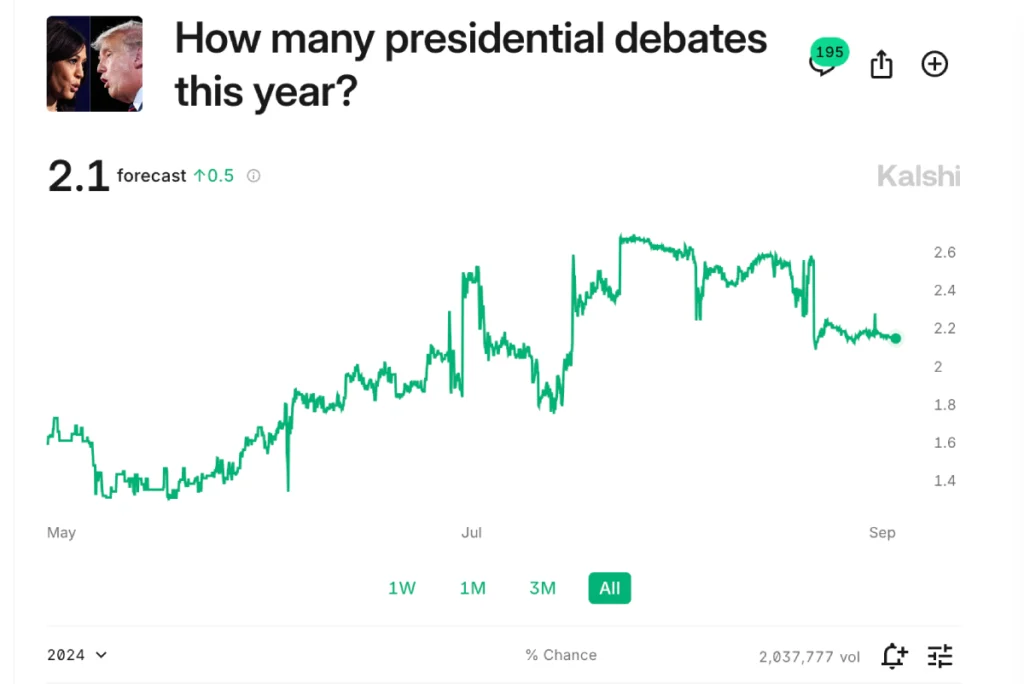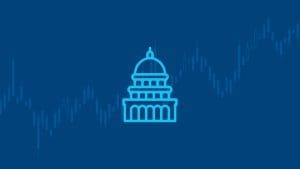On Oct. 1, J.D. Vance and Tim Walz will face off in a CBS debate. The VP debates’ goals and style differ from their presidential counterparts. Since the potential Vice Presidents can’t set policy or strategic visions, they have to speak to their campaigns’ values and not hurt their presidential candidates in post-debate polls.
The VP debate is likely the last chance for the campaigns to make their cases in a debate format. Kalshi forecasts only two presidential debates in total this election cycle. Polymarket gives another debate between Kamala Harris and Donald Trump a 22% chance.

Kalshi will settle this market based on the number of debates before election night. If a third debate occurs, the market will settle to three total debates this season. Without a third debate, the market will settle on two on election night. Kalshi expects to pay its contracts out within two hours of market settlement.
Polymarket has also begun releasing new markets on the VP debate. They include markets on which candidate will speak more and whether they will shake hands. On Sept. 25, Polymarket opened a market on who will win the VP debate according to post-debate polls.
VP debates tend to be more combative, less substantive
Historically, presidents have tried to maintain a level of civility in their campaigns. Even among the attack ads, candidates like Barack Obama, John McCain, and Mitt Romney shook hands with their opponents and made shows of grace at the presidential debates. The presidential candidates were also constrained by the need to balance attacks on their opponents with defenses of their own visions.
However, the Vice Presidents had more room to attack the opposing campaign. A 2005 study of presidential and VP debates found that the vice presidential debates:
- Featured more attacks on the opposition than the presidential debates
- Defenses of the presidential candidate were the most common response
- Both candidates tend to discuss policy in their answers more than character
- Perceived debate winners discuss policy more than the perceived loser
The VP candidates aren’t setting their own visions. Instead, they’re defending the visions their presidential candidates have run on. This will be a unique VP debate, because both presidential candidates have policy records. Trump had one term as president, and Harris is currently Biden’s Vice President. Even though she’s not setting policy, she has cast tie-breaking votes as President of the Senate in 2021 and 2022.
Small effect on presidential polls
The VP candidates may or may not swing voters to their tickets’ side. VP candidates are a minor but important piece of voters’ choices in November.
In 2008, Joe Biden and Sarah Palin faced off in a presidential debate on Oct. 2. On Oct. 30, NBC reported that the majority of respondents to a New York Times/Sienna College poll considered Palin unqualified to be Vice President while “about three quarters” of respondents believed Biden was.
That gap in perception began with the Oct. 2 debate. A Pew Research Survey conducted the week after the debate found that favorability ratings had changed little, but Biden had much better perceptions of his performance.
The Biden/Palin debate remains the most-watched VP debate in U.S. history. Its aftermath suggests that the fallout from the debate will be a slow burn. Whatever gaps between the VP candidates could be modest after the debate. However, those perceptions of performance and favorability could widen as the two candidates campaign through the election’s final weeks.
The VP debate winner will be a preview of how voter sentiment could change, especially if the VP candidates retain visible public profiles throughout the rest of the campaign.
























